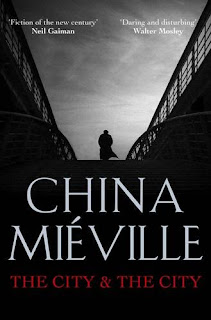
Portugal's largest fantasy and science fiction convention, The Fórum Fantástico 2010, is getting ready to open its doors to thousands of fans in Lisbon this weekend 12th-14th November.
The two Guests of Honour being flown in this year are the British fantasy author Stephen Hunt, and American fantasy author Peter V. Brett.
The three-day event also includes many Portuguese fantasy and science fiction authors & comic-book creators and artists, including Ricardo Pinto, David Soares, Afonso Cruz and João Pedro Duarte.
The event is being held in Portugal's capital in the stunning Biblioteca Municipal de Telheiras (state library).
Stephen Hunt was first published in 2007 after a fiercely fought auction for his debut fantasy novel, 'The Court of the Air'. The success of ‘The Court of the Air’ (it’s still the only debut fantasy novel to be given mass-market distribution by Tesco) helped kick-start a now rapidly growing sub-culture known as steampunk, with a slew of novels in the genre following in Hunt’s foot-steps on both sides of the Atlantic.
Books in Stephen's series include ‘The Court of the Air, ‘The Kingdom Beyond the Waves’, ‘The Rise of the Iron Moon, ‘Secrets of the Fire Sea’, ‘Jack Cloudie’ (pub: 2011), and a 6th as yet untitled work in the series due for publication in 2012.
The Jackelian series is published in the UK, Canada, Australia and New Zealand by HarperCollins; the USA by Tor; and as foreign language editions by various publishers in Japan, China, Russia, France, Germany, Portugal and Spain.
Peter V. Brett is an American writer of fantasy novels. He is the author of the ongoing 'Demon Series', whose first volume 'The Painted Man', was first published in the United Kingdom by HarperCollins's Voyager imprint in 2008. The book is known as 'The Warded Man' in the United States where Del Rey Books published it.
The first novel in Peter's Demon Series introduces a world formerly the home of an advanced human civilisation, now reduced to a 'dark age' by the attacks of demons, known as 'corelings'. The corelings are powerful beings, with magical abilities and differing elemental natures, and each night emerge from the planet's core to feed on humans. The story is told from the perspective of three main characters, Arlen, Leesha and Rojer, showing their passage from childhood to maturity and the beginning of their individual quests to bring an end to the terror that has befallen humankind. Each character possess differing talents, which develop across the tale, and will become key in the ongoing struggle.
Here is the schedule of Fórum Fantástico 2010:
November, 12th:
14,30 – The opening
15,00 – Panel “Classics of Portuguese Science Fiction” with Luís Filipe Silva, António de Macedo, João Barreiros and João Seixasm, moderated by Rogério Ribeiro
16,00 – Panel “New Portuguese Fantasy for New Readers” with Fábio Ventura, Bruno Martins Soares and Bruno Matos, moderated by Rogério Ribeiro
17,00 – Panel “Fantastic Art” with Victor Lages, Bruno Krippahl and Tiago Lobo Pimentel, moderated by Ana Maria Baptista
18,00 – Pause
18,30 – Release of “The Symbolic Space in The Lord of the Rings”, with the author Maria do Rosário Monteiro
19,00 – Panel “Portuguese Fantasy by Women”, with Madalena Santos, Inês Botelho and Susana Almeida, moderated by Safaa Dib
19,30 – Joint session of autographs
November, 13th
10,30 – The mechanics of writing fantasy (I) – “Worldbuilding”, by Ricardo Pinto
11,15 – The mechanics of writing fantasy (II) – “Invented Technology and Atmosphere” by Stephen Hunt
12,00 – The mechanics of writing fantasy (III) – “Characters and Characterization”, by Peter V. Brett
14,30 – “Fórum Fantástico: 5 years, and now?”, conversation with Rogério Ribeiro and Safaa Dib
15,00 – Panel “Fantastic Lisbon”, moderated by Rui Tavares, with João Barreiros, David Soares and Octávio dos Santos
16,00 – Portuguese Fantastic Cinema – Short movies (“The Hearing” by Francisco Campos and Henrique Bagulho, “Nocturne” by Francisco Carvalho, “The Bet” by Vasco Sequeira
17,00 – Pause
17,30 – Release of “The Homeless Light”, with the author David Soares
18,00 – Conversation with Ricardo Pinto, lead by Rogério Ribeiro
18,30 – Conversation with Stephen Hunt, lead by Luís Corte-Real
19,00 – Conversation with Peter V. Brett, lead by Pedro Reisinho
19,30 - Joint session of autographs
November, 14th
11,30 – The mechanics of writing fantasy (IV) – “When reality is mixed with the fantastic”, by David Soares
12,15 – The mechanics of writing fantasy (V) – “Notions of movie script for story writers and novelists”, by Luís Pereira (Monomito Argumentistas)
15,00 – Reading suggestions, with Ana Cristina Alves and João Barreiros
15,30 – Panel “The Comics”, with Filipe Melo, Nuno Duarte, Osvaldo Medina, Rui Ramos, Fil, André Oliveira and Diogo Carvalho
17,00 – Panel “The fantastic as a literary form”, moderated by João Morales, with Afonso Cruz and João Pedro Duarte
18,00 – Pause
18,30 - Portuguese Fantastic Cinema – Short movies (“The Bride” by Ana Almeida, “Epilogue” by Ricardo Quaresma and Maria Freire, “The Plastic Bag” by Bruno Canas) presented by Filipe Homem Fonseca and Nuno Duarte. Panel about the Portuguese fantastic cinema with Paulo Prazeres, Filipe Melo, Paulo Leite (Bad Behaviour), moderated by Filipe Homem Fonseca and Nuno Duarte
20,00 – The closing
During the event a Fair of Fantasy Book will be available, managed by the Dr.Kartoon bookshop, and with stands of Saída de Emergência publishing house and Runadrake game publisher.
I would love to take part to this convention, not only because the event looks wonderful, but also because Portugal is a very beautiful country and Lisbon is an amazing city.
















 2. Frédéric Perrin – “Tyrant’s Blood” by Fiona McIntosh (Bragelonne)
2. Frédéric Perrin – “Tyrant’s Blood” by Fiona McIntosh (Bragelonne) 


 4. Didier Graffet – “Prince of Dogs” by Kate Elliott (Milady)
4. Didier Graffet – “Prince of Dogs” by Kate Elliott (Milady)
























